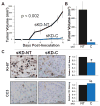EGFR Is Regulated by TFAP2C in Luminal Breast Cancer and Is a Target for Vandetanib
- PMID: 26832794
- PMCID: PMC4783288
- DOI: 10.1158/1535-7163.MCT-15-0548-T
EGFR Is Regulated by TFAP2C in Luminal Breast Cancer and Is a Target for Vandetanib
Abstract
Expression of TFAP2C in luminal breast cancer is associated with reduced survival and hormone resistance, partially explained through regulation of RET. TFAP2C also regulates EGFR in HER2 breast cancer. We sought to elucidate the regulation and functional role of EGFR in luminal breast cancer. We used gene knockdown (KD) and treatment with a tyrosine kinase inhibitor (TKI) in cell lines and primary cancer isolates to determine the role of RET and EGFR in regulation of p-ERK and tumorigenesis. KD of TFAP2C decreased expression of EGFR in a panel of luminal breast cancers, and chromatin immunoprecipitation sequencing (ChIP-seq) confirmed that TFAP2C targets the EGFR gene. Stable KD of TFAP2C significantly decreased cell proliferation and tumor growth, mediated in part through EGFR. While KD of RET or EGFR reduced proliferation (31% and 34%, P < 0.01), combined KD reduced proliferation greater than either alone (52% reduction, P < 0.01). The effect of the TKI vandetanib on proliferation and tumor growth response of MCF-7 cells was dependent upon expression of TFAP2C, and dual KD of RET and EGFR eliminated the effects of vandetanib. The response of primary luminal breast cancers to TKIs assessed by ERK activation established a correlation with expression of RET and EGFR. We conclude that TFAP2C regulates EGFR in luminal breast cancer. Response to vandetanib was mediated through the TFAP2C target genes EGFR and RET. Vandetanib may provide a therapeutic effect in luminal breast cancer, and RET and EGFR can serve as molecular markers for response.
©2016 American Association for Cancer Research.
Conflict of interest statement
Figures






References
Publication types
MeSH terms
Substances
Grants and funding
LinkOut - more resources
Full Text Sources
Other Literature Sources
Medical
Molecular Biology Databases
Research Materials
Miscellaneous

